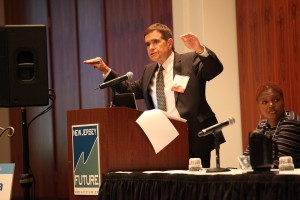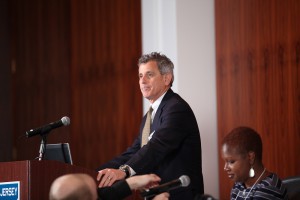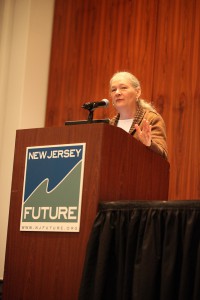New Jersey Future Blog
Forum Plenary: A Tale of Three Cities
April 17th, 2014 by Elaine Clisham
One of the major redevelopment challenges that New Jersey faces is that of reviving its older cities: How can sufficient human and financial capital be organized around a revitalization effort that can often take decades? The morning plenary session at the 2014 Redevelopment Forum offered lessons from three cities that are meeting that challenge – Providence, Cincinnati and Detroit. All three have faced barriers similar to some of those faced by New Jersey’s cities – most notably how to bring private investment to a downtown that has a reputation for being unattractive or worse – and while each pursued a very different path to overcoming them, all three approaches offer lessons for New Jersey’s cities.
In Providence, said Dan Baudouin, the executive director of the Providence Foundation, the urge for downtown redevelopment began in the 1970s and 1980s, when business leaders realized that, even though the city was home to much corporate investment, it was ugly and no one wanted to be there; no one felt any affinity to the physical place. Out of those conversations grew the Providence Foundation, funded by the private sector and institutions in the city, and which has served as a long-term catalyst for the removal of barriers to development; a connector of resources and opportunities; and a constant across different city administrations.
They started with small projects, and delivering on those successes allowed them to aim much higher – “relocating misplaced assets,” as Dan Baudouin puts it, including shifting the location of railroad tracks and an interstate highway, and re-opening a river that had long ago been paved over. The foundation also houses the downtown Business Improvement District for the city. The success of Providence today can be seen in repurposed historic buildings like the Biltmore Hotel and Arcade Providence, once a shopping mall and now home to shops and microlofts.
Dan Baudouin’s recommendations for successful downtown revitalization can be applied at any scale: leverage funding; network key organizations and support staff; don’t underestimate the importance of a good maintenance budget; and “beware the traffic engineers!”
In contrast to Providence, Cincinnati took a more direct approach to working with the private sector. According to Steve Leeper, the president and chief executive officer of the Cincinnati Center City Development Corporation (3CDC), the organization realized there were several major employers in the Cincinnati region, and3CDC worked with them to establish several real-estate development funds, which they used for land-banking. To address the challenge of retail turnover and to increase business retention in newly redeveloped properties, they devised a flexible rent program that allowed small retailers to pay either a low flat rent or a percentage of their sales. This helped to give businesses enough time to build a customer base, and it maximized street-level activity to help lend an air of safety and vibrancy.
Midtown Detroit, Inc. (MDI), the non-profit organization responsible for community development within Detroit’s University Cultural Center and New Center districts, did not have the luxury of a large private-sector base from which to draw support. So, according to its president, Susan Mosey, it has relied on the anchor educational and medical institutions in the district. MDI is hampered by the fact that many of these organizations are not taxpaying, so the organization has focused on revitalization efforts that don’t require much up-front financing – incentives to encourage the employees of anchor institutions to move to the district, for example, working with those institutions to link more completely to the community, and trying to retrofit local streets from being entirely car-centric to being welcoming to all users.
Even though each city’s approach is different, all three speakers did cite one strategy in common for enlivening a revitalizing downtown – lots of programming. Providence has its signature downtown event, WaterFire; Cincinnati draws people to a variety of events in Fountain Square; and Midtown Detroit puts on arts events such as Art X Detroit and DLECTRICITY. The other thing all three cities have in common is the long-term energy and steadying influence of organizations like the ones represented on the panel – organizations that work with, but not inside the cities’ political leadership, and can keep and implement a long-term vision across decades rather than mayoral terms.




















Beware the traffic engineers, indeed! I hope to see the Providence Foundation pushing the city harder from the outside on getting a decent bike plan, improving on the proposed streetcar and not not not not (please!) not building any more parking garages (please!).
So far there’s not enough energy going into these goals, but I have hope.
I grew up in NYC, and do not want to ever go back to attached home or high-rise living. If developers can build small, efficient 1-story homes for 55+ communities, why do they have to be in mega “resort” developments in the middle of nowhere (cheaper land), instead of smaller clusters w/o all the amenities, in a walkable area?
Why doesn’t NJ institute regulations that new developments with > X units, must either be within 1 mile of basic shopping, or the developer must incorporate those facilities in their plans on the boundary of the residential area?!